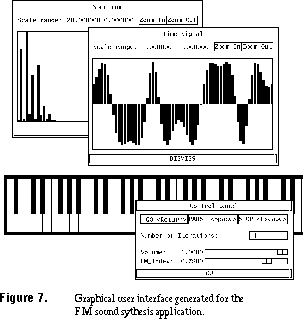5 Examples

The application specification is hierarchical. Two of the actors have been expanded to expose the hierarchy. All of the actors in the top-level description outside of the dotted arcs expand to graphs similar to the one at the top of the figure. Note the peek/poke actors in this graph. As their icon suggests, they provide the disconnection between the dataflow graphs; each is expanded to a peek/poke pair as shown in figure 4. The peek/poke actors disconnect the top subgraph from the subgraph that runs on the DSP. All of the other actors that run on the workstation similarly disconnect themselves from the graph running on the DSP. This allows the DSP subgraph to run as fast as necessary without synchronizing with the workstation. In this case, the sound is generated at a 32 kHz sampling rate. If we had not disconnected the graph with peek/poke actors, but rather used synchronizing send/receive actors, we would have slowed the DSP to run in lock step with the workstation, preventing the DSP from running at the required rate.